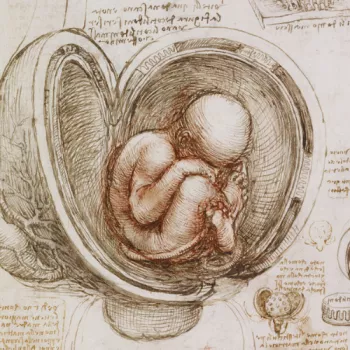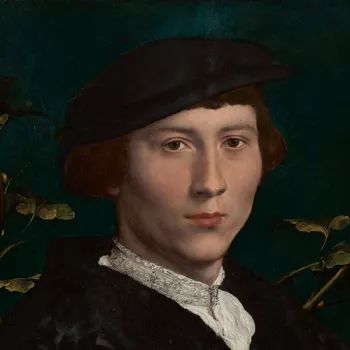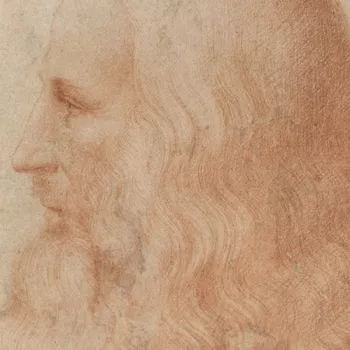
Leonardo in the Royal Collection
A closer look at Leonardo da Vinci's works.
The Life of Leonardo da Vinci
What do Leonardo's drawings tell us about his life and achievements?
By Martin Clayton, Head of Prints and Drawings
Reading time: 3 minutes
During his lifetime Leonardo da Vinci had attained fame as a painter, sculptor, architect and engineer. But many of his works had remained unfinished, and few people knew of his remarkable scientific investigations.
It is primarily through Leonardo’s drawings and notes that we can understand the man and his achievements. He drew incessantly – to devise his artistic projects, to explore the natural world, and to record the workings of his imagination. Leonardo kept thousands of these drawings to the end of his life, leaving them to his favourite pupil Francesco Melzi, to ensure that his legacy would be preserved.
Around 550 of these drawings entered the Royal Collection in the 17th century, mounted on the pages of a single album. They give a unique picture of one of the most remarkable minds in history.
Florence, to 1481
Leonardo was born in 1452 near the town of Vinci in central Italy. He was the illegitimate son of a lawyer and a peasant girl and was raised in his paternal grandfather’s house. We know little else about his early years.
By the age of 20 Leonardo was working as a painter in nearby Florence. This was a period of great experimentation in Florentine art: a generation of young artists were using drawing to devise compositions and to study figures, faces and the world around them.
Around 1480 Leonardo began his most ambitious early painting, the Adoration of the Magi – teeming with figures but also with animals, and Leonardo made many studies for the animals in the background. This painting remained unfinished when Leonardo left Florence for Milan, probably in late 1481.
Milan, 1483-1499
Leonardo had moved to Milan in north-west Italy by April 1483, when he received the commission for an altarpiece now known as the Virgin of the Rocks. Later that decade he entered the service of the ruler of Milan, Ludovico Sforza – initially to work on an equestrian monument, and later painting portraits, designing entertainments, and executing his greatest finished work, the Last Supper. This was to be Leonardo’s longest period in a single city, ending when an invading French army overthrew Ludovico in 1499.
While in Milan, Leonardo’s interests broadened rapidly. He developed a reputation as an architect and engineer, and he began to study light, colour, proportion, anatomy and other scientific subjects that would be of use to an artist.
Florence, 1500-1506/8
After the fall of his patron Ludovico Sforza in Milan, Leonardo returned to Florence. He tried to re-establish himself there as a painter but was reported to be preoccupied with geometry and ‘very impatient with the brush’, and in 1502 he left Florence to work as a surveyor to the papal army.
Leonardo was back in the city the following spring, when the Florentine government commissioned him to paint a huge mural, the Battle of Anghiari. He worked on that painting for the next three years, while also making maps and beginning other paintings including Mona Lisa and Leda and the Swan.
In 1506 the French occupiers of Milan requested Leonardo’s return to that city, and for two years he travelled repeatedly between Florence and Milan. While this was an unsettled period artistically, he threw himself into the study of subjects such as anatomy and botany, heralding his greatest scientific achievements over the next five years.
Milan, 1506/8-1513, and Rome, 1513-1516
Leonardo served the French court in Milan for much of the next seven years. While he did turn his hand to some paintings (notably the St Anne, possibly for the King of France), Leonardo was now working more as a designer and scientist. His intended treatise on painting, begun 20 years earlier, had spawned several distinct strands of investigation – optics, water, the figure in motion, and especially anatomy.
But once again military strife disrupted Leonardo’s work. The French were ousted from Milan, and in 1513 Leonardo abandoned Milan for Rome. He was based there for the next three years but achieved little of note, and in 1516 he left Italy forever, and moved to France.
France, 1516-1519
In late 1516, aged 64, Leonardo accepted an offer of employment at the court of the young King Francis I. He moved from Rome to Amboise in central France, where he held a privileged position as painter, engineer and architect to the king. Leonardo was an adornment to the court and served the king primarily as a designer – of architecture, costumes, festivals, and another equestrian monument.
But Leonardo’s health was deteriorating and in October 1517 he was reported to have a paralysed right arm, perhaps from a stroke. He became increasingly obsessed by visions of a vast tempest overwhelming the earth and made a long sequence of drawings of this apocalyptic deluge.
Leonardo died at Amboise in France on 2 May 1519, aged 67. He took care to preserve his legacy, leaving his drawings – 2000 or more loose sheets – and dozens of notebooks to his pupil Francesco Melzi.
Many of these drawings and notes have survived to the present day, but they were widely published and understood only from the late 19th century. We now have a greater understanding of Leonardo’s life, work and thought than at any time since his death. His remarkable drawings allow an insight into one of the greatest minds of the Renaissance.










